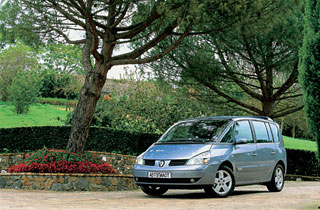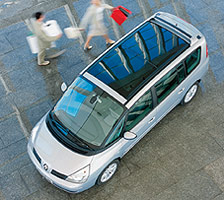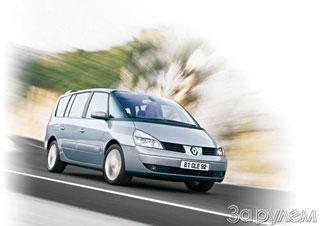Test drive by Renault Espace 2002 - 2006 Minivan
Between heaven and earth
Renault Espace II - Wheel living spaceYou have got a big family? Do you constantly have to transport oversized things? Do you prefer to travel by car? If at least one of these questions is a positive answer, it's time to look closely at the minivans. In the European market, the most popular of them is Renault Espace.
Very often you can hear that it was Renault Espace that became the first minivan on the planet. This is not entirely true. The official Espace debut took place in mid -1984, but back in 1983 in the United States, Chrysler introduced a car of a similar class. Well, then the single -combatants began to appear with many manufacturers. The advantages of the minivans were appreciated immediately. They combined the best qualities of two completely different types of cars - from minibuses, minivans received spaciousness and the possibility of transporting a large number of passengers, and from cars, they were sold out comfort and ease of control. It would seem almost the perfect car. However, Russian buyers of used cars do not really like minivans. And the point is not only that such cars are more expensive than cars. It is believed that they break more often than the usual sedans or hatchbacks. Statistics shows that used single -combatants in reliability ratings are often in the last places.
Renault Espace was originally developed not Renault, but by the Matra aerospace company, which had its small production production production. Moreover, the car was made on the facilities of Matra, which by that time possessing all the necessary resources for the production of a sufficient number of plastic bodies. And as a result of the first generation Espace, it was made of this material. The second generation of Renault Espace also had a plastic body (by the way, the new Espace has already become metallic) and, in fact, was only a deep modernization of the previous car. Naturally, a huge advantage of plastic cars - they do not rot. Except that the frame of the minivan is made of metal, but it is also covered with galvanizing, reliably protecting it from the red -haired plague.
But do not idealize Espace. He really has no problems with corrosion, however, when the plastic parts hit the accident, they often just crack. And it is impossible to decrypt them. That is why, after damage to the car, the owners of Renault Espace are forced to contact spare parts and order new body elements there. Someone rightly notice that for old cars a lot can be bought at a showdown, and not pay crazy money for original details. This is all, of course, true, but not for Espace. As practice shows, these machines come across disassembly extremely rarely. I must also say that in Russia few car services can really paint plastic qualitatively, and therefore, sometimes a year or two after work, the applied paint and varnishes begins to bargain. Well, in defense of the plastic body, we can say that with light clashes, when only cracks appear, the damaged part is treated without special problems with fiberglass and epoxy putty.
Carious sixes
For the hood of the second generation, the Renault Espace installed four engines. The weakest of them was a 2.1 liter diesel engine with a capacity of 88 hp. or 90 hp A little, of course, especially if you take into account the large dimensions of the car. This diesel was installed on various Renault models back in the 80s, it has a decent resource and quite calmly digested Russian diesel fuel. Although it is not necessary to talk about his eternity, so customers of diesel Espace need to be very careful when diagnosing (the repair of a diesel engine requires considerable funds, and not every mechanic will take up it).
Gasoline engines in most cases are 4-cylinder. The volume of one of these units is 2.0 liters (103 hp), the other is 2.3 liters (107 hp, although 108 hp or 110 hp are indicated in some reference books). With the same power, a more voluminous engine has a noticeable stock of traction, which allows you to feel more confident during overtaking. It should be noted that it is 4-cylinder engines that are considered the most optimal for Renault Espace. They are quite reliable, and their repair is not much more complicated than other similar power units. At the same time, the engines calmly digest our 92nd gasoline. According to Renault repair experts, these motors with proper maintenance can work easily more than 300 thousand km. Then, however, this or that repair may be required (it is very difficult to say exactly what needs to be replaced).
To date, on many machines you can find a small leak of oil through the gasket of the crankcase pallet. It’s not worth worrying about this - work on replacing the leaky gasket will require about $ 30.
Immediately after purchasing a car (and then every 60 thousand km), it is recommended to change the timing belt. Spare parts and work are inexpensive (for a 4-cylinder engine), so it is perhaps not worth making every penny on this operation. After all, if the strap breaks off (and this sometimes happens after 70 thousand km), more than $ 700 will have to threaten the engine repair. When operating, Renault Espace must carefully monitor the cooling system. Antifreeze must be changed strictly according to the schedule and clean the radiator at least once a year. Otherwise, in the summer he can clog and lead to ineffective work of the entire system - and this very quickly ends with the overheating of the motor, which he is very afraid. In addition, the owners of the used Espace periodically complain about the flow of the cooling system or breakdown of the water pump (replacing the latter costs $ 50-80). By the way, all kinds of engine oil seals can also snot. However, if the oil goes in small quantities, regular valley is enough.
But even if the 4-cylinder engine begins to be capricious, its maintenance is not too expensive. What can not be said about the most powerful V6 engine with a volume of 2.8 liters (150 hp), which appeared under the hood of Espace simultaneously with the debut of the second generation of Minivan in 1991. Despite the fact that Espace with a 2.8-liter six becomes a truly fast car, Renault repair mechanics do not recommend such a model for purchase.
It is believed that the V6 motor resource is not more than that of modest 4-cylinder units, but it is much more demanding of the quality of fuel and oil. The mechanics are also unhappy that the six is \u200b\u200bvery difficult to serve, since there is very little free space under the hood of Espace V6. As a result, to replace some penny sensor, you have to spend a lot of time (so the prices for repairs are appropriate). And besides, the fuel consumption of cars with a 2.8-liter engine can not be called modest, even given the size of the minivan. According to the owners of the Espace V6, in the city, with a more or less active ride, 15-17 liters of 95th gasoline per 100 km of path are leaving, although only 11.6 liters are indicated in the technical characteristics. So when buying a used minivan, you need to remember that a powerful six will require decent financial costs.
Does it flow? Well, let!
Sometimes you can find all -wheel drive Renault Espace Quadra. On the asphalt, Espace Quadra has a drive to the front axle, but when slipping, the rear wheels also enter into business. Of course, the cross -country ability of such ESPACE is noticeably better than conventional monoproding cars, but their repair often requires large costs. After all, the car has a different rear suspension, and Wyskirta is also capable of failing. In general, it is probably better to opt for a simple modification.
The gearbox in the French minivan can be either mechanical and automatic. The latter is quite rare and mainly only on cars with a 6-cylinder engine. Naturally, the presence on the Espace V6 of the machine also does not reduce the costs that the owner carries. The Renault Espace automatic box is considered quite reliable, but, alas, to date, it can junk. Still, years take their own. If everything is in order with the automatic transmission, the owner of the Espace must remember that the oil in the box must be changed earlier than the recommended 40 thousand km (it is better to do this after 20 thousand km). However, in any case, after a run of 200 thousand km, the machine will still require repairs ($ 600-1200).
Mechanics causes fewer problems. Although you can often hear complaints that the box flows. Indeed, there is such a problem, but in most cases it is much easier and cheaper to just add oil than to disassemble the CP and change the seals. Moreover, sometimes after replacing them after 15-20 thousand km, everything is repeated. By the way, there are two types on Espace - for the V6 engine, its own KP (of course, its maintenance and repair cost more). The grip of the Renault Espace is moderately reliable, and its replacement is required approximately every 100-150 thousand km (it costs $ 180-250 on cars with 4 cylinder engines). The carcasses of the car are very strong and are able to serve almost all their lives. But only if the boiler is not torn. Otherwise, the grenade will quickly break. And you will have to buy all the axis assembly, since separately the CHRUS is not available (the price of the part is $ 250).
The suspension of the French minivan cannot be called a miracle of engineering thought. In front, it is independent with the reptile stability stabilizer, and the back is semi -dependent with a torsion beam. In ordinary modifications, Espace Hind suspension very rarely requires attention. Only shock absorbers and silent blocks can worry there. The latter can serve more than 150 thousand km, and their replacement costs a little. But the car could be equipped with a sophisticated air suspension. It consists of a pump, sensors of the body position and expensive hydropneumatic shock absorbers that can change the road clearance of the car.
The cost of one part, which sometimes breaks after 20-30 thousand km, is more than $ 140-190. That is why often when failing of pneumatics, the owners prefer to remove it and put ordinary shock absorbers and springs (one normal shock absorber costs $ 50-80). Although it happens that the rear spring bursts on Renault Espace with a conventional suspension. And sometimes this is imperceptible even when driving with full load. The branded set costs about $ 300, and it is difficult to find suitable parts from other models (the springs in the Espace are not entirely standard and have an alternating interval distance). But you can order good non-original springs for $ 100-140.
The front suspension also does not cause special criticism. Everything is simple and quite reliable there, and most importantly - its repair is quite cheap. But the chassis must be constantly inspected, and if some new knock or creak appeared during the ride, it is better to go to the service. According to the masters, the Renault Espace pendant is characterized by the fact that some worn element quickly destroys the rest of the details. By the way, it is worth noting that cars with a heavy 2.8-liter engine have less front suspension resource.
Espace steering has a hydraulic wrap. There may be the same problem with him - leakage. Moreover, the replacement of the oil seal most likely will not help. This is already the development of the details of the steering rack itself, which needs to be changed entirely (about $ 800). So it is much easier to wave to leaks with your hand and do not forget to add new liquid.
EXCURSION
The French company Matra took up the development of a fundamentally new car with an unusual design in the early 80s. Moreover, the first time Matra collaborated with Peugeot, but subsequently the latter decided to get out of the project, not believing in the possibility of a commercial success of the car with a very strange body for that time. But a holy place is not empty, and the initiative of Matra experts was supported in Renault.
As a result, in mid -1984, the first European minivan Renault Espace was represented (translated from French - space or space). Initially, Espace had three rows of seats that could be transformed at the request of the driver, remove, rearrange and so on. Espace was equipped with a 2-liter carburetor engine (110 hp), but a little later diesel and more advanced gasoline units with a volume of 2.0 and 2.2 liters appeared with a fuel injection system.
At the very beginning of 1988, an all -wheel drive version of Espace Quadra was also released, and the next year a small restyling model took place (the car received new headlights, a different radiator grill, etc.).
Well, in 1991, a new model was shown, which is sometimes called the deep modernization of the first -generation Renault Espace. This car was equipped not only with gasoline 4-cylinder engines with a volume of 2.0 and 2.2 liters, but also by a powerful 2.8-liter V6, which produced 150 hp. (placed under the hood and turbodiesel with a volume of 2.1 liters). In 1995, the basic equipment of the car, which received airbags, expanded.
By the way, in the same 1995, a truly unique Espace F1 car was presented. It was created by Renault, Matra and Williams. Espace F1 was based on the chassis from the formula car, and the body was made of carbonate.
As a power unit, a V10 motor was used with a volume of 3.5 liters, which produced 800 hp! Thanks to this engine, Espace F1 accelerated from a place to 100 km/h for 2.8 s, and up to 200 km/h for 6.9 s. The maximum speed of the car was 312 km/h. However, during one of the indicative races, Espace F1 shattered.
In 1996, the third generation of Renault Espace was represented with a completely new running part and body. The car was equipped with gasoline engines with a volume of 2.0 and 2.9 liters (power from 114 hp to 190 hp), as well as a 2.2-liter turbodiesel (113 hp). In 1997, an elongated version of the minivan, called Grand Espace, was shown.
At the end of 2002, the French introduced the fourth version of Espace already in a metal body. The car is produced both with a regular and elongated base. Under the hood of Espace IV put gasoline motors with a volume of 2.0 liters (136 hp or 163 hp) and 3.5 l (241 hp), as well as three diesel engines with a volume of 1.9 l (120 liters . S.), 2.2 l (150 hp) and 3.0 l (177 hp).
Renault Espace is a wonderful car for a large family. In addition, this machine is quite affordable in price and in the service service relatively inexpensive. True, this does not apply to sophisticated specimens with V6 engines, all -wheel drive transmission or pneumatic suspension. The cost of operating such machines is noticeably higher than simple Espace with 4-cylinder units.
Text: Denis Smolyanov
Source: Mkobil magazine [07.02.2005]
Video Crash tests Renault Espace 2002 - 2006
Test drives Renault Espace 2002 - 2006
Renault Espace 2002 Krash Test - 2006
Krassh Test: Detailed Information35%
Driver and passengers
10%
Pedestrians











